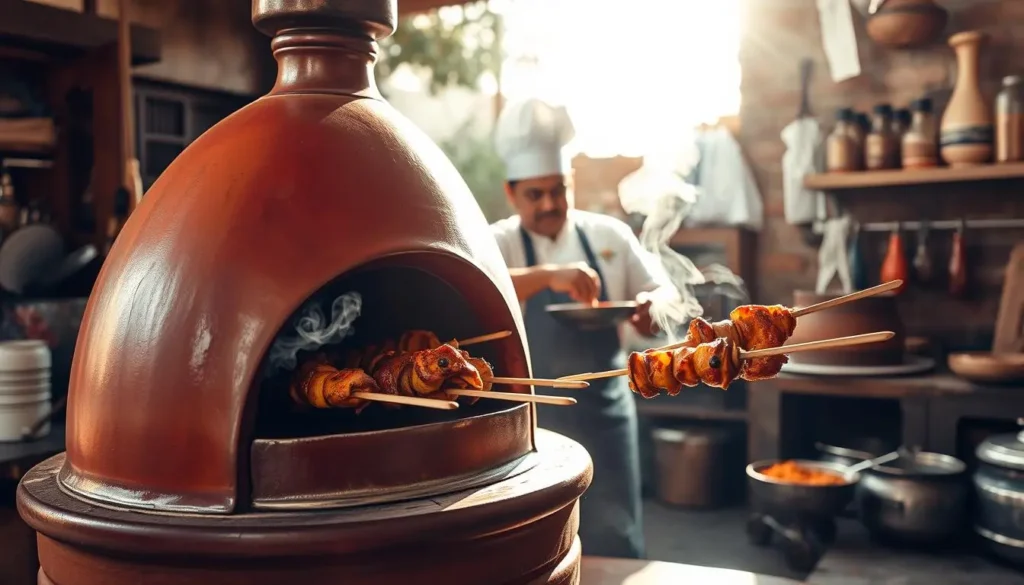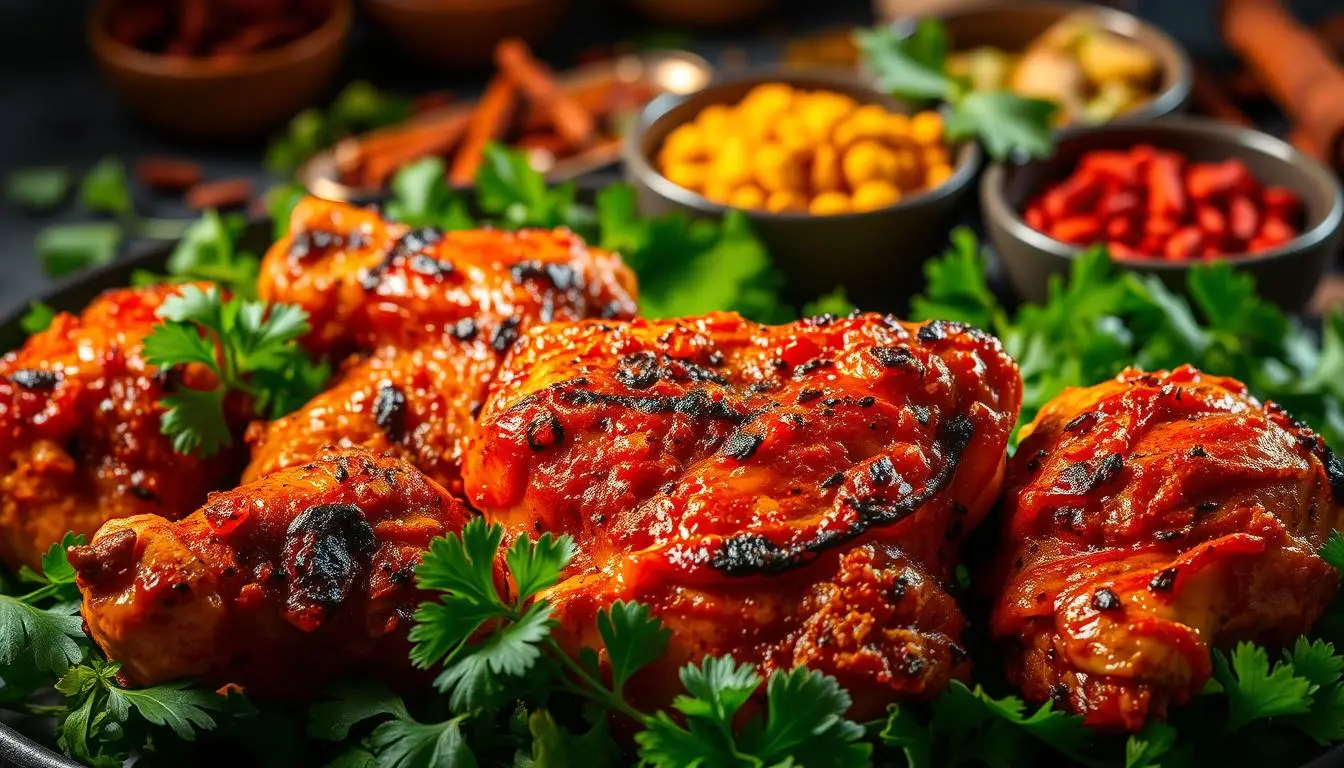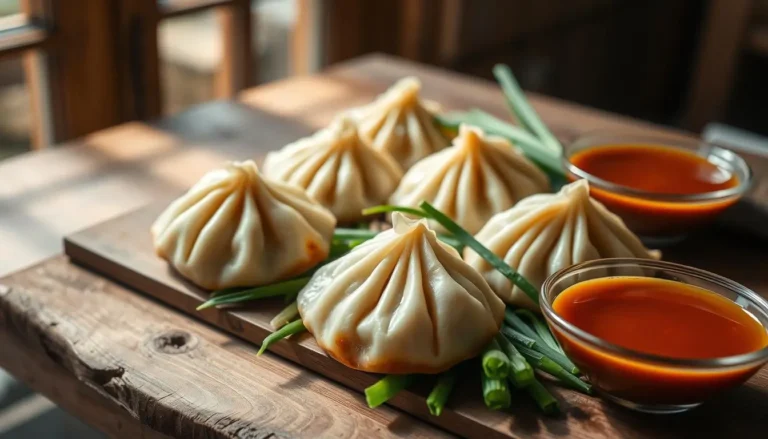Tandoori Chicken: Savory and Succulent Indian Dish
Imagine the first bite of tandoori chicken—its smoky taste, the spices that stick to the meat. This dish is more than just food; it connects us to Punjab’s kitchens. There, chickens marinated in yogurt and spices became a legend.
From street carts to fancy restaurants, tandoori chicken is loved by millions. It’s a mix of tradition and something everyone wants to try.
Table of Contents
Key Takeaways
- Tandoori chicken’s roots trace to Punjab, now a globally adored popular Indian dish.
- A 24-hour marinade with hung yogurt ensures deep flavor penetration.
- Traditional tandoors hit 500°C, but home ovens at 250°C can still deliver smoky results.
- Avoid microwaves—their heat can’t mimic the charred depth of authentic cooking.
- Regional variations use spices like cumin and Kashmiri chili to balance heat and aroma.
What Is Tandoori Chicken?
At the heart of indian cuisine, tandoori chicken is a mix of yogurt marinades and smoky clay-oven cooking. It’s known for its authentic indian flavors from spices like cumin, garlic, and fenugreek. This makes the dish tender and aromatic. Over time, it has changed to fit local tastes but stayed true to its roots.
The Rich History Behind This Popular Indian Dish
| Time Period | Key Event | Impact |
|---|---|---|
| 3000 BC | Tandoor ovens used in Harappan civilization | Early clay oven cooking techniques |
| 1947 | Moti Mahal restaurant in Delhi refines the recipe | Became a national symbol |
| 1962 | Served to Jacqueline Kennedy during a flight | Global popularity surge |
Cultural Significance in Indian Cuisine
This dish is more than food; it’s a cultural symbol. It’s a hit at weddings and festivals and is a must-have at official events. Its fame on menus worldwide shows its impact on indian cuisine globally. From village tandoors to Michelin-starred kitchens, its appeal is timeless.
Regional Variations Across India
| Region | Flavor Profile | Signature Spice |
|---|---|---|
| North India | Fiery and robust | Red chili powder |
| South India | Herbal and citrusy | Curry leaves, coconut |
From Punjab’s bold red chilies to Kerala’s coconut marinades, each region puts its own twist on tandoori chicken. Yet, they all keep the core authentic indian flavors. This makes tandoori chicken a symbol of India’s rich culinary heritage, both unified and diverse.
The Secret to Authentic Tandoori Chicken Marinade
Mastering the marinade chicken process starts with understanding balance. The perfect blend requires yogurt as the base. Its acidity and fat content tenderize meat and carry spices deep into the fibers. Use ½ cup plain yogurt to lock in moisture and ensure your flavorful chicken dish doesn’t dry out.
- Spice ratios matter: 1 tbsp each of garam masala, paprika, and onion powder. Reduce garlic and ginger to 1 tbsp each (minced) to avoid overpowering the dish.
- Add 1 tbsp lemon juice for acidity, ½ tsp cumin, and ¼ tsp cayenne (adjust to taste).
- End with 1 tbsp cilantro leaves and 2 tsp dried herbs for freshness.
Over-marinating isn’t the issue—proportions are key. Too much garlic or ginger creates a sharp bite, while excessive cayenne adds heat over balance. Let the chicken sit for at least 3 hours (overnight ideal) to ensure even flavor penetration. Separate the marination into two stages: coat chicken first, refrigerate, then stir in spices 4 hours before cooking for layered flavor.
Pro tip: Use Kashmiri chili powder for vibrant red color without extra heat. The result? A juicy, subtly spiced main course where no single ingredient dominates—just the harmonious taste of a true flavorful chicken dish.
Traditional Clay Oven Cooking vs. Modern Methods
Mastering tandoori chicken means learning about clay oven cooking. The tandoor’s thick walls and shape trap heat well. This heat can reach up to 500°C, giving the chicken a smoky flavor and juicy inside.

The Magic of Tandoor Ovens
Traditional clay ovens use charcoal or wood for heat. This high heat sears the meat and adds smokiness. The oven’s design keeps the heat even, so the meat stays juicy.
Before cooking, marinated chicken is brushed with oil. This helps the flavors soak into the meat better.
How to Recreate Tandoori Flavors at Home
To make tandoori chicken at home, you need to be creative. Here are some tips:
- Preheat a cast-iron skillet to 450°F (230°C) for 15 minutes. This imitates the oven’s sear.
- Smoke chicken with wood chips in a grill or oven. This adds a deep flavor.
- Brush chicken with yogurt marinade before baking. Use spices like cumin, coriander, and paprika to keep it moist.
Common Cooking Mistakes to Avoid
To keep the traditional recipe true, avoid these mistakes:
- Don’t over-marinate chicken for more than 8 hours. Too much spice can overpower the meat.
- Always preheat your oven or grill. This ensures even cooking.
- Choose thick, bone-in chicken pieces. They cook better and stay juicy.
| Traditional Clay Oven | Modern Adaptations |
|---|---|
| Uses charcoal/wood for heat | Electric/grill heat sources |
| 500+°C temperatures | 425–450°F (218–232°C) |
| Direct radiant heat | Convection or broiler settings |
| 15–20 minute cooking time | 30–40 minutes for oven/grill |
Step-by-Step Tandoori Chicken Recipe
Turn your kitchen into a spice paradise with this tandoori chicken recipe. It’s been shared over 24,700 times. It combines tangy and smoky flavors for a taste just like a restaurant.
- ½ to ¾ lb bone-in chicken thighs/legs
- 1/3 cup Greek yogurt
- 2 tbsp lemon juice, 2 tbsp oil, minced garlic, ginger
- Spices: garam masala, Kashmiri chili, cumin, turmeric, salt
- Optional: red food color, melted butter
- Prep chicken: Slash skinless thighs 3-4 times. Pat dry.
- Blend marinade: Mix yogurt, lemon, oil, garlic, ginger in a blender. Add spices and blend until smooth. Pour over chicken, making sure it’s fully coated.

- Marinate: Refrigerate 6-48 hours. Turn occasionally.
- Cook:
- Grill: 25-30 mins over medium charcoal for spicy grilled chicken.
- Oven: Bake at 375°F for 30 mins, flipping halfway.
- Air fryer: 380°F for 20 mins, flipping halfway.
- Rest 5 mins before serving with naan or rice.
Make sure the chicken is 165°F inside. Adjust the chili powder for your spice preference. This dish has 376 calories and 27g of protein. Try it with yogurt-based raita or mango chutney for a complete meal.
Serving and Pairing Your Tandoori Chicken
Make your meal better with the right sides. In Indian food, the best flavors come from pairing them well. Here are some tips to mix tradition with new ideas.
- Essential sides: Try garlic naan, cucumber raita, or tangy coriander chutney. For a casual meal, go for Indianish potato salad or air-fryer cauliflower steaks. These are modern yet true to Indian tastes.
- Beverage picks: Mango lassi, spiced chai, or a crisp white wine are great. They bring out the dish’s spices without being too strong.
- Quick prep: Raita is quick, under 5 minutes. Mix yogurt with mint, cucumber, and cumin for a cool contrast.
| Traditional Pairing | BBQ-Friendly Option |
|---|---|
| Saffron rice with dal | Air-fryer turmeric potatoes |
| Onion bhajis | BBQ potato wedges with chaat masala |
| Kachumber salad | Indianish slaw with lime dressing |
Put chicken on a warm platter with sliced onions, lemon wedges, and fresh cilantro. Add pomegranate seeds or roasted cashews for color. This makes the dish look vibrant, fitting both traditional and modern tastes.
Pair with up to 30 sides, like paneer tikkas or wholewheat naan. The goal is to balance flavors so each dish complements the chicken’s smoky taste. Whether it’s a classic meal or a BBQ, these choices make every bite a taste of India.
Conclusion
Tandoori Chicken is a popular Indian dish loved for its bold spices and tender meat. The yogurt marinade, with cumin, turmeric, and chili powder, brings out a rich flavor. It’s perfect whether cooked in a tandoor or a home oven.
This flavorful chicken dish captures India’s culinary traditions. It also welcomes new twists. Marinating for 4–24 hours makes the flavors deep and adds nutrition from yogurt.
The smoky heat and bright colors of Tandoori Chicken make it a hit. It’s often served with cool raita or fragrant basmati rice. Even leftovers are great in wraps or salads, showing its versatility.
Tandoori Chicken has come a long way from clay ovens to modern kitchens. You can play with spices or presentation, like adding cilantro. Sharing your take connects you to a long history of tradition and creativity.
Enjoying it at home or in a restaurant shows the beauty of Indian cuisine. It’s a mix of tradition and innovation.
FAQ
What is tandoori chicken made of?
Tandoori chicken is made from chicken marinated in yogurt and spices. These spices include garam masala and Kashmiri chili powder. The marinade makes the chicken taste better and stay tender.
How did tandoori chicken originate?
It started in the Punjab region of India during the Mughal era. Now, it’s a favorite dish around the world, loved for its true Indian taste.
Why is yogurt used in the marinade?
Yogurt tenderizes the chicken and adds a tangy flavor. This makes the chicken juicy and gives it a unique taste.
Can I make tandoori chicken without a clay oven?
Yes, you can make it at home without a tandoor. Use ovens, grills, or air fryers. Techniques like baking stones or “dhungar” smoking can help you get close to the real taste.
What are common mistakes to avoid when preparing tandoori chicken?
Don’t overcook the chicken or forget to preheat your equipment. Also, avoid wet marinades that can steam the chicken. The right method is key for the authentic taste.
What traditional side dishes pair well with tandoori chicken?
Pair it with naan, roti, or paratha for a traditional taste. Raita and chutneys add coolness, while flavorful rice makes the meal complete.
How can I present tandoori chicken attractively?
Use garnishes like sliced onions, lemon wedges, and fresh herbs. Arrange them on heated platters to make the dish look stunning.





